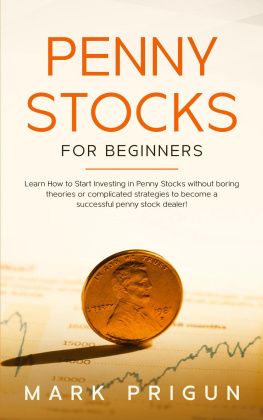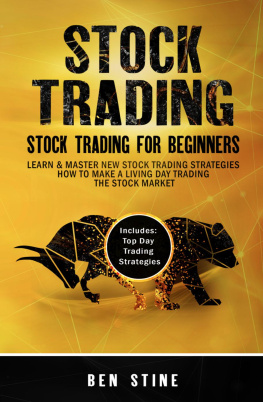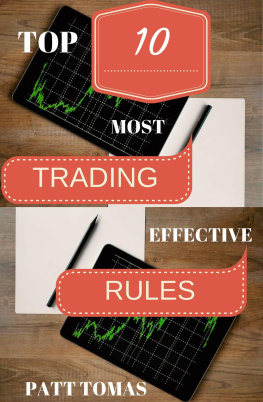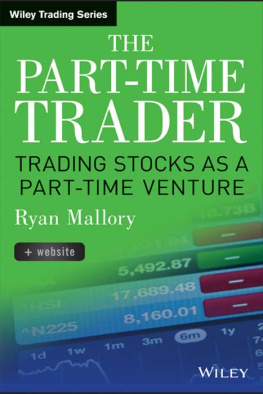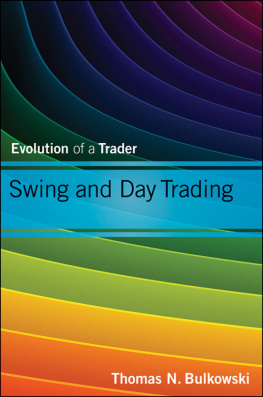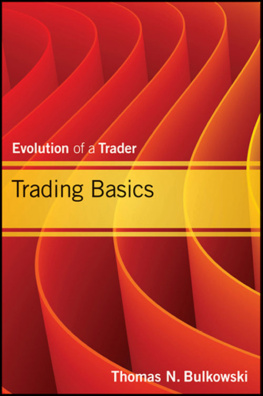The Beginner's Guide to Day Trading: How to Trade Penny Stocks
Discover the Power of Day Trading Penny Stocks and Master the Strategies of a Good Trade
By: Benjamin Tyce
Publisher Notes
Disclaimer
This publication is intended to provide helpful and informative material. It is not intended to diagnose, treat, cure, or prevent any health problem or condition, nor is intended to replace the advice of a physician. No action should be taken solely on the contents of this book. Always consult your physician or qualified health-care professional on any matters regarding your health and before adopting any suggestions in this book or drawing inferences from it.
The author and publisher specifically disclaim all responsibility for any liability, loss or risk, personal or otherwise, which is incurred as a consequence, directly or indirectly, from the use or application of any contents of this book.
Any and all product names referenced within this book are the trademarks of their respective owners. None of these owners have sponsored, authorized, endorsed, or approved this book.
Always read all information provided by the manufacturers product labels before using their products. The author and publisher are not responsible for claims made by manufacturers.
Copyright 2014 Benjamin Tyce - All rights reserved.
Table of Contents
DEDICATION
This book is dedicated to all first time traders looking for a way to trade while at the same time managing risks.
Introduction
A person interested in the stock market commonly asks about day trading. The initial question usually is What is day trading? Day trading is similar to trading stocks and equities. However, the difference is that stocks are going to be sold on the same day.
Positions (stocks) are never held overnight; instead they are sold within market hours before the close of the day. Day trading is a different strategy, compared to traditional trading that many investors in the past have engaged in.
For a beginner, the initial answer to What is day trading? can be vague. And follow up questions can be posted by the fresh investor. How does it work, When shall I buy, and what will I buy, When shall I sell, How I will earn? These questions will be answered in the succeeding chapters.
Many people are engaged in day trading for a number of reasons. The top most reason is easy money when you hit the jackpot. In order to hit the jackpot, the trader has to be experienced.
Day Trading and Gambling
In essence, day trading is a gamble and not really an investment.
As a beginner in day trading, guessing most likely will not take you anywhere. If you rely on hope and guesswork to make a quick profit through the daily changes in stock prices, your investments may go to waste. The possibilities that your trade is going to sell high at the end of the day may quiver and shatter.
On the other hand, there are professional day traders who carefully study the flow of the market and make it big in day trading. If a day trader does not involve careful study as part of his strategy in day trading, most of his activities will be considered a gamble.
So if you are thinking that day trading is a good source of extra money, the answer may be a yes or a no. Yes for day traders who know what they are doing, and No for day traders who place their fate on luck.
Risks and benefits
Like gambling, the risks are high, but the benefits can be good. Ive known a lot of investors who lost a lot of money in the process. However, in one or the other, in time they are able to get back what they lost. That is when they are able to learn the tricks of the industry.
The benefits are huge once an investor understands the market. Its like a game of chess and the opponent is the market. Your move is critical, it may lead you to checkmate or may lead you to win the game.
CHAPTER 1
History of Day Trading
Tracing a Brief History of Day Trading
Day Trading and all its controversies, has a short history to follow, which was made possible through several significant occasions and rules in the years of trading. Take a look at significant events that have made an impact on the evolution of day trading.
1867
Following the development of the telegraph, the very first ticker tape was created, making it very easy to communicate information concerning deals occurring on the exchange floor with brokers. A lot of brokers who traded at the New York Stock Exchange kept an office nearby to ensure they were obtaining a stable supply of tape and the most present information.
1928
At the peak of the stock markets bull market, the traders do not have direct access to the market where all orders should pass through a broker where information is gathered through the ticker tape.
1971
The NASD has formed NASDAQ, their very own Electronic Communication Network (ECN)a computer system that manages financial trades outside the premise of stock exchanges.
1975
This is the year that marked the beginning of the discount brokerage era. It was also in this year that SEC abolished fixed commission system and trading fees were set for the first time after 180 years.
1987
Firms who trade NASDAQ securities are mostly done over the phone, which is the main reason they were able to ignore small investors who tried to call in a trade during the stock market crash; to block them out they simply didnt answer the phones. In this regard, SEC has launched the SOES, Small Order Entry System which gives priority to 1,000 shares or less.
1997
This year marks the impact of technology in trading. Many e-trades have started to launch their websites that further publicized the trading industry to the public. It was in also the year small traders had direct access to price quotes and other trading activities. Big traders have reasoned that the market has favored small traders who took advantage of SECs SOES.
1999
Day trading has gained more publicity. Records show 7,000 small traders involved offline, while 5M small traders are recorded using online access. Mark Barton made headlines after a shooting spree at the Atlanta day trading office where he argued that day trading was so stressful it could drive a person to commit a gruesome murder. Two weeks after the shooting, it was reported that 7 out of 10 day traders have lost everything.
2000
SEC has changed the SOES policies to remove the many benefits of day traders, which lead to yet one more collapse in the market. This was the peak of the dot-com bubble burst, which frightened many day-trading opportunists and led them to bankruptcy.
2008
In place of the lawless days of day trading, professional day traders chase the market with care and diligence.
At present, there are many ECNs running side by side with NASDAQ. There is a rise in numbers of day trading firms from various locations all over the country and even across the globe. With the rise of technology, day trading will prove to stay. Day trading comes with high risks, but it has gained a legitimate, well managed and organized career that can compete with traditional trading houses.



